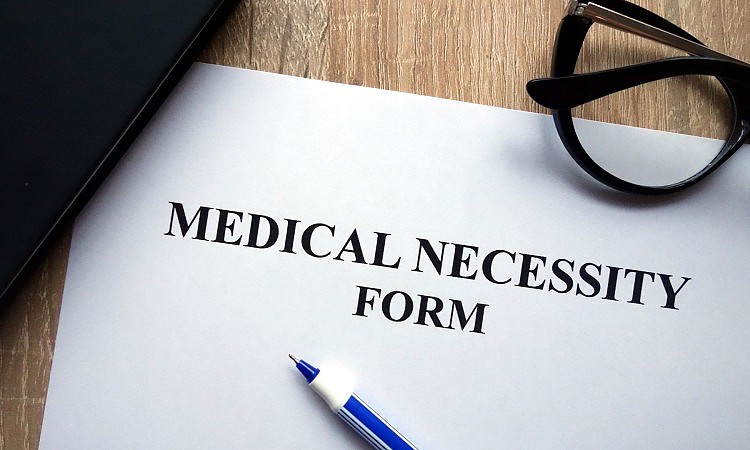There are a lot of benefits to using a standing desk. Sitting is not very good for you, so opting to stand up while working can reduce your risk of weight gain and developing diseases associated with being overweight or obese.
Standing can also reduce back pain, increase productivity, and help with your mood. Think about how you feel after spending your day slouched in an office chair staring at a computer–not great, right?
With all of these health benefits attached, it would be perfect if you could get a prescription for one from a doctor. Well, the good news is that you can!
Here’s what you need to know about getting a standing desk for medical purposes.
Table of Contents
Do Doctors Recommend Standing Desks?

Standing desks have become increasingly popular in the last decade or so. The idea that you don’t need to be glued to a chair from 9 to 5 is revolutionary and is part of the movement to make workdays healthier and happier.
To start, standing doesn’t exhaust you as much as you think it would. Sitting burns 80 calories an hour, regardless of what you’re doing (watching TV, answering emails, writing the best piece of literature known to man, etc). Standing burns 88 calories in the same amount of time.
That may not seem like a lot of calories, but it does add up, and at the end of the day, calories aren’t everything.
Doctor’s recommend standing desks for several reasons, including that “after a meal, blood sugar levels return to normal faster on days a person spends more time standing.” It can also reduce the risk of cancers, diabetes, heart disease, premature death, and ease shoulder and back pain.
However, all these benefits aren’t necessarily just attached to standing desks. Spending less time sitting, regardless of how you do it, will give you an opportunity to enjoy these benefits. Therefore, if you like to walk around in between taking calls seated, that’s perfectly fine, too.
Doctor’s don’t recommend that you go from sitting all day to standing all day, though. Any extreme change in your physical routine comes with risks. Instead, you should start standing more gradually.
Begin with 30 to 60 minutes a day and work your way up. Set a timer if that helps!
Can You Get a Prescription for a Standing Desk?

For some people, getting a standing desk is essential to feeling better while staying productive. In these cases, getting a prescription for a standing desk is possible.
Just because a standing desk isn’t a pill or injection, doesn’t mean it lacks the medical benefits traditional medicine offers. Ergonomic equipment can help with pain, mood, and weight management.
Keep in mind that your doctor may not offer to use a standing desk at first, so you might have to bring it up yourself. Tell them that you’ve been exploring the benefits of standing and that you think it may help soothe some of your issues.
You don’t need a prescription for a standing desk, but it will help you not have to pay for it all yourself. Unfortunately, insurance only covers what your doctors think you need, not what you think you need.
How Do I Get a Doctor’s Note for My Standing Desk?

There are two types of benefits to build a case off of: medical or business. As an individual, you should build your case off the medical benefits. Building a business case for receiving a standing desk is possible, but you won’t need a doctor to do that.
A doctor’s note, also known as a Letter of Medical Necessity, is a document from your doctor explaining how a product or piece of equipment is important for the individual’s health and how the patient will benefit from receiving said piece of equipment.
A few potential diagnoses that would benefit from a standing desk include chronic discogenic pain, chronic back pain (upper or lower), cervicogenic headaches, and chronic neck pain. Your doctor doesn’t need to use these specific diagnoses, this is to give you an idea of what a Letter of Medical Necessity might include.
Several types of medical professionals can write a Letter of Medical Necessity. Registered nurses, doctors, physical therapists, occupational therapists, and chiropractors can all write these letters. If you want to build a strong case for receiving a standing desk, you should have more than one doctor sign the letter.
You should explain your job to your doctor. Paint them a picture of what an average day looks like for you and how sitting is partially or fully responsible for your ailments.
Take the time to write out the lists of tasks you perform weekly. Giving the doctor a physical piece of paper to look at will show how serious you are about receiving the desk.
However, keep in mind that only your doctor will be able to make the final decision on whether or not to write the letter. If your general doctor doesn’t see the benefits to the desk, you may want to see a specialist with a better understanding of ergonomics.
Listing previously tried and failed treatments will further cement the argument that a standing desk is the other option. If you’ve had a chance to try out a standing desk, let your doctor know. Including that in the letter will help your case.
This page has a great example of a Letter of Medical Necessity.
Are Standing Desks FSA Eligible?

FSAs help cover the costs of medical purchases like birth control and Epipens. They make a living with the medication and lifestyle adjustments you need cheaper. But don’t automatically assume everything you need is going to be covered by your FSA.
On the FSA website, they say that standing desks are not eligible with an FSA account. This may be disheartening, but don’t give up yet!
This is where that Letter of Medical Necessity comes in. If you’re able to build a solid case around why you need certain ergonomic equipment, they will cover it for you.
We aren’t saying doing that is going to be easy. After all, what company willingly gives out their money?
To start, you need to purchase the standing desk with your own money. There are lots of great models on the market, so look carefully before deciding!
You might have to get an Explanation of Benefits (EOB) from your insurance company (along with the Letter of Medical Necessity) to be reimbursed for your standing desk.
Once you’ve got the doctor’s note, the receipt of purchase for the standing desk, and the EOB, it’s time to make a claim with your FSA. Take your time and be sure to include as many details as possible. You know you need that desk… now let them know, too!
How Can I Get Help Paying for a Standing Desk?

If you work in an office, working with your company to get you one is a great way to go about it. Your superiors may be unfamiliar with standing desks and their benefits, so educating them on how one could help you feel better and be a better employer is a good way to start.
If you’re lucky to work for a company with a human resources or wellness department, that’s a great place to go. Good companies know that taking care of their employees is akin to taking care of their business and profits.
Remember that it’s difficult to work well when you’re in pain and that requiring employees to stay seated eight hours a day is unrealistic and unsympathetic. You are not asking for a lot by requesting help to do your job comfortably.
If you decide to go down the insurance/FSA route, make sure you aren’t spending too much of your budget on the desk if you have other medical expenses that need to be taken care of. Planning is important regardless of what you’re doing, but purchasing through your insurance requires extra consideration.
In Conclusion

You can get a prescription for a standing desk. Maintaining a good ergonomic form is essential to living a long healthy life without serious health complications or detrimental weight gain.
The most important part of the whole process is talking to your doctor. Be honest and transparent about your needs and how you think a standing desk will help. Remember to write things down so you can leave them with a paper that details your work routine.
If going down the medical route doesn’t seem possible, try working with your place of business. Don’t feel embarrassed for asking for help. Besides, the worst that can happen is that they say no.
Start by asking your superior for advice, then talk to human resources if that doesn’t work.
Have you had success getting your standing desk via a prescription? Did you get it paid for? We’d love to hear all about your experiences navigating the complicated world of insurance and if you were successful.
Good luck finding the ergonomic support you need!

My name is Vance, and I am the owner of To Ergonomics. Our mission is to improve your workflow by helping you create a supportive and welcoming environment. We hope that you’ll find what you’re looking for while you’re here.

